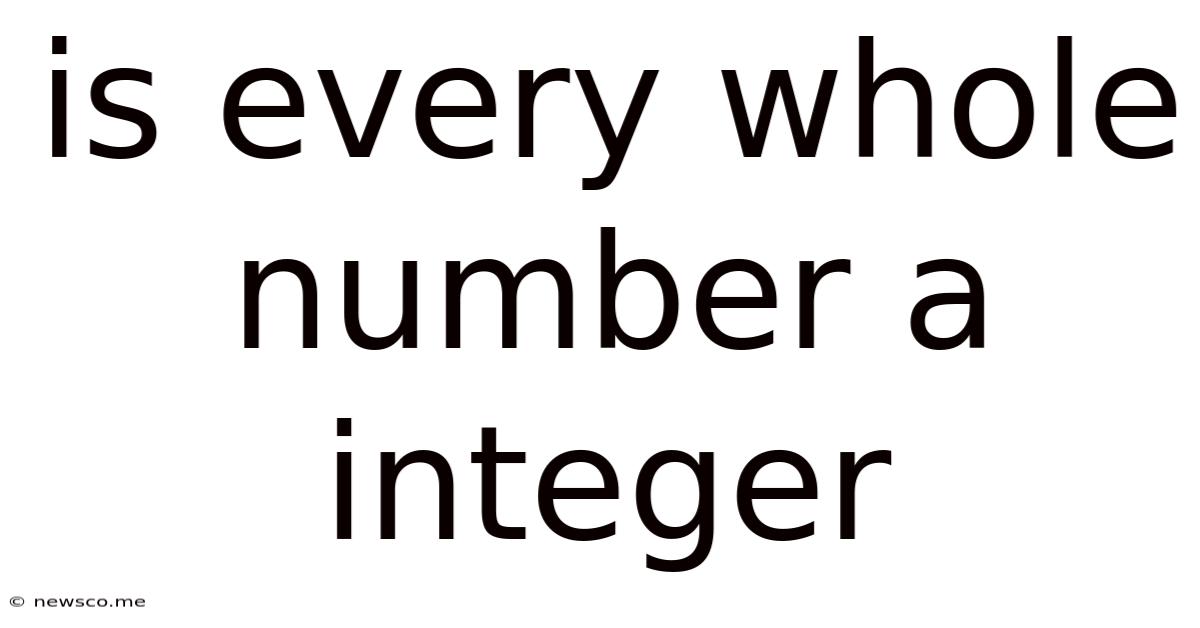Is Every Whole Number A Integer
News Co
Apr 21, 2025 · 5 min read

Table of Contents
Is Every Whole Number an Integer? A Deep Dive into Number Systems
The question, "Is every whole number an integer?" might seem trivial at first glance. For those familiar with basic number systems, the answer is a resounding yes. However, a deeper exploration reveals a fascinating journey through the world of mathematics, uncovering the nuances of number classifications and their hierarchical relationships. This article will not only answer the core question but also provide a comprehensive overview of various number systems, explaining their properties and interconnections.
Understanding Number Systems: A Foundation
Before we definitively answer the central question, let's establish a firm understanding of the key number systems involved: whole numbers and integers. This foundation is crucial for appreciating the relationship between them.
Whole Numbers: The Building Blocks of Counting
Whole numbers are the foundation of arithmetic. They represent the natural numbers we use for counting, starting from zero and extending infinitely. The set of whole numbers is often denoted as W and can be represented as:
W = {0, 1, 2, 3, 4, 5, ...}
Whole numbers are non-negative, meaning they are either zero or positive. They are essential for everyday counting, measuring, and basic arithmetic operations. Their simplicity belies their fundamental importance in mathematics and beyond.
Integers: Expanding Beyond Counting
Integers represent a broader category of numbers that include whole numbers but also extend to their negative counterparts. The set of integers is usually denoted as Z and is defined as:
Z = {..., -3, -2, -1, 0, 1, 2, 3, ...}
Integers encompass both positive and negative whole numbers, as well as zero. They are crucial for representing quantities that can increase or decrease, such as temperature, altitude, or financial balances. The inclusion of negative numbers significantly expands the scope of mathematical operations and problem-solving.
The Crucial Relationship: Whole Numbers and Integers
Now, we can directly address the core question: Is every whole number an integer?
The answer is yes. Every single whole number is also an integer. This is because the set of whole numbers is a subset of the set of integers. In simpler terms, all whole numbers are contained within the larger set of integers. Think of it like this: all apples are fruits, but not all fruits are apples. Similarly, all whole numbers are integers, but not all integers are whole numbers.
Visualizing the Relationship
A Venn diagram effectively illustrates this relationship:
Integers (Z)
-----------------
| |
| Whole Numbers (W)|
| |
-----------------
The circle representing whole numbers (W) is entirely contained within the larger circle representing integers (Z). This visual representation clearly demonstrates that every element in the smaller circle (whole numbers) is also an element in the larger circle (integers).
Expanding the Number System Landscape
To further solidify our understanding, let's briefly explore other number systems and their relationship to whole numbers and integers:
Natural Numbers (N): The Counting Numbers
Natural numbers are essentially the same as whole numbers, but they exclude zero. They are the numbers we use to count objects:
N = {1, 2, 3, 4, 5, ...}
Natural numbers are a subset of both whole numbers and integers.
Rational Numbers (Q): Fractions and Decimals
Rational numbers include all numbers that can be expressed as a fraction p/q, where p and q are integers, and q is not zero. This includes all integers, as well as fractions and terminating or repeating decimals.
Q = {p/q | p, q ∈ Z, q ≠ 0}
Whole numbers and integers are subsets of rational numbers.
Irrational Numbers (I): Beyond Fractions
Irrational numbers cannot be expressed as a fraction of two integers. These numbers have infinite non-repeating decimal representations, such as π (pi) and the square root of 2.
Real Numbers (R): The Complete Picture
Real numbers encompass all rational and irrational numbers. They represent all points on the number line. Whole numbers, integers, rational numbers, and irrational numbers are all subsets of real numbers.
Complex Numbers (C): Extending Beyond the Real Line
Complex numbers extend beyond the real number line and include imaginary numbers, which involve the square root of -1 (denoted as 'i'). While outside the scope of our primary focus, understanding their existence helps to complete the picture of the number system hierarchy.
Practical Applications and Significance
The distinction between whole numbers and integers, while seemingly subtle, has practical implications in various fields:
- Programming: Many programming languages have specific data types for integers and whole numbers, with different memory allocation and operational capabilities.
- Accounting: Integers are crucial for representing financial transactions, while whole numbers might be used for counting inventory items.
- Physics: Integers are frequently used to represent discrete quantities, such as the number of particles in a system, whereas real numbers are essential for representing continuous quantities like distance or velocity.
- Mathematics: The precise classification of numbers is essential for developing theorems, proofs, and advanced mathematical concepts.
Conclusion: A Firm Understanding
The answer to "Is every whole number an integer?" is definitively yes. This seemingly simple question serves as a springboard for exploring the rich and interconnected world of number systems. Understanding the hierarchical relationships between whole numbers, integers, and other number systems is fundamental for anyone seeking a deeper understanding of mathematics and its diverse applications across various disciplines. By grasping these foundational concepts, we equip ourselves with the tools necessary to tackle more complex mathematical problems and appreciate the elegance and power of the mathematical framework. The seemingly simple relationship between whole numbers and integers underpins a vast and fascinating field of study.
Latest Posts
Related Post
Thank you for visiting our website which covers about Is Every Whole Number A Integer . We hope the information provided has been useful to you. Feel free to contact us if you have any questions or need further assistance. See you next time and don't miss to bookmark.